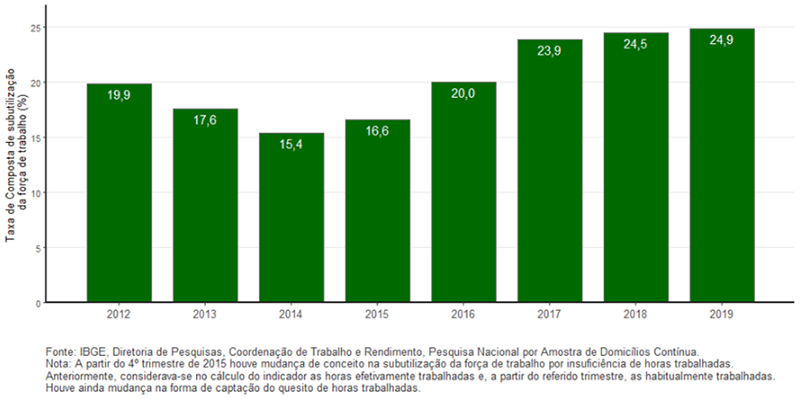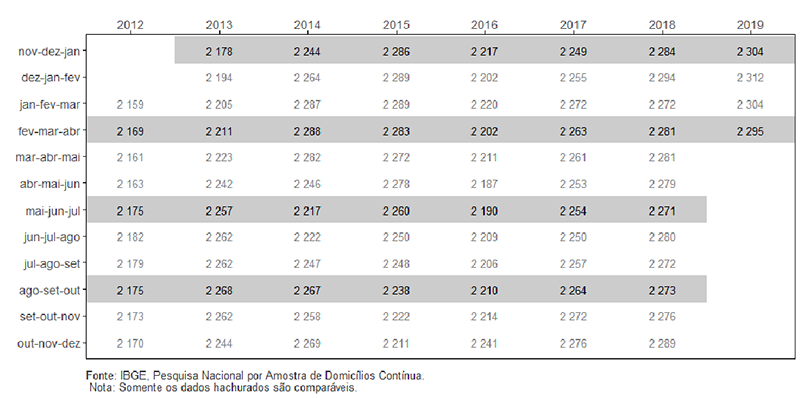Continuous PNAD: unemployment rate is 12.5% and underutilization rate is 24.9% in quarter ended in April 2019
May 31, 2019 09h00 AM | Last Updated: June 03, 2019 11h39 AM
In the quarter ended in April 2019, the unemployment rate (12.5%) changed 0.5 percentage points (p.p.) in relation to the quarter from November 2018 to January 2019 (12.0%) and dropped (-0.4 p.p.) compared with the quarter between February and April 2018 (12.9%).
| Indicator/Period | Feb-Mar-Apr 2019 | Nov- Dec (2018)-Jan 2019 | Feb-Mar-Apr 2018 |
|---|---|---|---|
| Unemployment rate | 12.5% | 12.0% | 12.9% |
| Underutilization rate | 24.9% | 24.2% | 24.5% |
| Usual real earnings | R$2,295 | R$2,304 | R$2,281 |
| Change in usual real earnings in relation to: | - 0.4 (stable) | 0.6% (stable) | |
The unemployed population (13.2 million persons) changed 4.4% (more 552 thousand persons) against the previous quarter (12.6 million persons) and remained stable in relation to the same period in 2018 (13.4 million persons).
The employed population (92.4 million persons) remained stable compared with the previous quarter (92.3 million persons) and increased 2.1% (more 1,937 thousand persons) in the comparison with the same period in 2018 (90.4 million persons).
The population out of the workforce (65.0 million persons) remained stable against the quarter from November 2018 to January 2019 (65.3 million persons) and also against the same quarter last year (64.9 million persons).
The underutilization rate of the workforce (24.9%) changed 0.7 p.p. in relation to the quarter between November 2018 and January 2019 (24.2%) and rose 0.4 p.p. in the comparison with the same quarter in 2018 (24.5%).
Having risen in both comparisons, the underutilized population (28.4 million persons) was a record in the time series started in 2012: 3.9% (more 1,063 thousand persons) against the previous quarter (27.3 million persons) and 3.7% (more 1,001 thousand persons) compared with the same quarter in 2018 (27.4 million persons).
The number of discouraged persons (4.9 million) increased 4.3% (more 202 thousand persons) in relation to the previous quarter (4.7 million persons) and 4.2% (more 199 thousand persons) against the same quarter in 2018 (4.7 million persons).
The number of persons employed in the private sector with a formal contract – excluding domestic workers – was 33.1 million persons, remaining stable against the previous quarter and rising 1.5% (more 480 thousand persons) against the same period in 2018. On the other hand, the number of persons employed without a formal contract (11.2 million persons) remained stable against the previous quarter and increased 3.4% (more 368 thousand persons) in relation to the same quarter in 2018.
The category of the self-employed workers (23.9 million persons) remained stable against the previous quarter and rose 4.1% (more 939 thousand persons) against the same period in 2018.
The average usual real earnings (R$2,295) remained stable in both comparisons. Conversely, the usual real wage bill (R$206.8 billion) remained stable in relation to the previous quarter and rose 2.8% (more 5.7 billion) against the same period in 2018.
Unemployment Rate - Brazil - 2012/2019

The unemployment rate was 12.5% in the moving quarter ended in April 2019, changing 0.5 percentage points in relation to the quarter from November 2018 to January 2019 (12.0%). It dropped (-0.4 p.p.) compared with the quarter between February and April 2018 (12.9%).
13.2 million persons were unemployed in Brazil in the quarter from February to April 2019. This contingent changed 4.4% (more 552 thousand persons) against the quarter from November 2018 to January 2019 (12.6 million persons) and remained stable compared with the same quarter last year (13.4 million persons).
The compound underutilization rate of the workforce - percentage of unemployed persons, time-related underemployed persons and persons in the potential workforce in relation to the extended workforce - was 24.9% in the quarter from February to April 2019, representing a change of 0.7 p.p. over the quarter from November 2018 to January 2019 (24.2%). It rose 0.4 percentage points in the comparison with the same moving quarter in the previous year (24.5%).
Compound underutilization rate of the workforce
quarters from February to April - 2012/2019 Brazil (%)

28.4 million persons were underutilized in Brazil in the quarter between February and April 2019. This contingent changed 3.9% (more 1,063 thousand persons) against the quarter from November 2018 to January 2019 (27.3 million persons) and 3.7% (more 1,001 thousand persons) compared with the same quarter last year (27.4 million persons).
The contingent of underemployed persons in terms of number of hours worked was of 7.0 million in the quarter from February to April 2019. It increased 3.3% (more 223 thousand persons) over the previous quarter (6.8 million persons). The increase was of 11.9% (more 745 thousand persons) in relation to the same period in 2018 (6.3 million persons).
In the quarter between February and April 2019, the potential workforce – persons aged 14 years and over who were neither employed nor unemployed in the reference week, but had a potential to turn into workforce – was of 8.2 million persons. This population grew 3.6% (more 287 thousand persons) compared with the quarter from November 2018 to January 2019 and 5.7% (more 439 thousand persons) against the same quarter a year ago.
The contingent out of the workforce was of 65.0 million persons in the quarter between February and April 2019. This population remained stable in the comparison with the quarter from November 2018 to January 2019 and against the same quarter in 2018.
The discouraged population was of 4.9 million persons in the quarter between February and April 2019. It rose 4.3% (more 202 thousand persons) over the previous quarter (4.7 million discouraged persons) and 4.2% (more 199 thousand persons) against the same period in 2018 (4.7 million discouraged persons).
The percentage of discouraged persons in relation to the population in the workforce or discouraged was of 4.4% in the quarter from February to April 2019, changing 0.2 p.p. in relation to the quarter between November 2018 and January 2019 (4.3%). It remained stable in the comparison with the same quarter last year (4.3%).
The workforce – employed and unemployed persons – was of 105.5 million persons in the quarter from February to April 2019. This population increased 0.6% (more 627 thousand persons) when compared with the quarter between November 2018 and January 2019 and 1.7% (more 1.8 million persons) against the same quarter in 2018.
The number of employed persons reached 92.4 million in the quarter from February to April 2019, which represented a stability in relation to the previous quarter and a rise of 2.1% (more 1,937 thousand persons) against the same period in 2018.
The employment-population ratio – percentage of employed persons in the population at working age – was estimated at 54.2% in the quarter from February to April 2019, remaining stable against the quarter between November 2018 and January 2019 (54.2%) and rising 0.6 p.p. in relation to the same quarter a year ago (53.6%).
The contingent of persons employed in the private sector with a formal contract – excluding domestic workers – was of 33.1 million persons, which represented a stability against the previous quarter and a rise of 1.5% (more 480 thousand persons) over the quarter from February to April 2018.
In the period between February and April 2019, the category of the persons employed in the private sector without a formal contract (11.2 million persons) remained stable against the previous quarter and increased 3.4% (more 368 thousand persons) over the same period in 2018.
The category of the self-employed workers, made of 23.9 million persons, recorded a stability in the comparison with the quarter between November 2018 and January 2019 and a rise of 4.1% (more 939 thousand persons) in relation to the same period last year.
In the period from February to April 2019, the category of the employers (4.4 million persons) remained stable in relation to the previous quarter and to the same quarter in 2018.
The number of domestic workers (6.1 million persons) remained stable against the previous quarter and the same period in 2018.
Estimated at 11.5 million persons, the group of persons employed in the public sector – including statutory servants and military – remained stable against the previous quarter and the same quarter in 2018.
The average usual real earnings (R$2,295) remained stable in both comparisons.
The usual real wage bill (R$206.8 billion reais) remained stable against the quarter from November 2018 to January 2019 and rose 2.8% (more R$5.7 billion) in relation to the same quarter a year ago.
Average monthly real earnings, usually earned in the reference month,
from all jobs of employed persons - Brazil - 2012/2019 - (R$)


